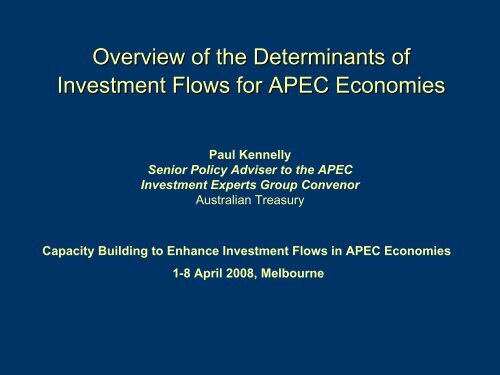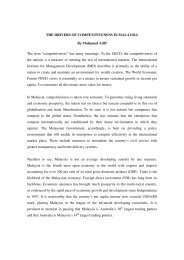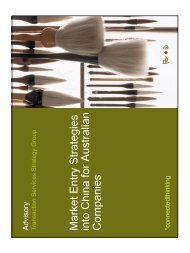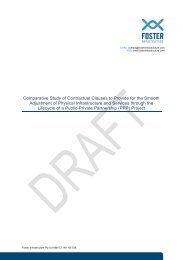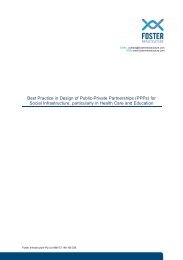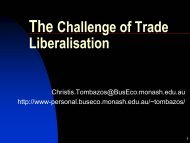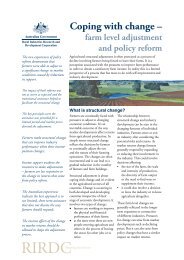Enhancing investment flows in APEC - Introductory Presentation
Enhancing investment flows in APEC - Introductory Presentation
Enhancing investment flows in APEC - Introductory Presentation
Create successful ePaper yourself
Turn your PDF publications into a flip-book with our unique Google optimized e-Paper software.
<strong>Presentation</strong> Structure• Overview• At Border Barriers to FDI Flows• Beh<strong>in</strong>d-the-Border Barriers to Foreign andDomestic Investment
Overview• 1) Fall<strong>in</strong>g poverty across <strong>APEC</strong> and drivers ofpoverty reduction and susta<strong>in</strong>able development• 2) <strong>APEC</strong> work on <strong><strong>in</strong>vestment</strong> to address theseissues– Stage 1 Study: At Border Barriers– Stage 2 Study: Beh<strong>in</strong>d-the-Border Barriers• 3) Summation of Key Issues• 4) What to do?
1). Poverty rates have fallen across <strong>APEC</strong>Per cent of <strong>APEC</strong> population60504030201001988 2000$1 a day $2 a day
The key role of <strong><strong>in</strong>vestment</strong>InvestmentGrowthPoverty reduction
Drivers of poverty reduction andsusta<strong>in</strong>able development• Growth leads to poverty reduction• Only two ways <strong>in</strong>come per person can grow– Productivity (the amount of output per unit of <strong>in</strong>put)– Investment (more capital per person)• Foreign Direct Investment (FDI) offers both• But there are significant barriers to FDI amonglow <strong>in</strong>come <strong>APEC</strong> economies– Border barriers– Beh<strong>in</strong>d-the-border (BTB) barriers
Drivers of poverty reduction andsusta<strong>in</strong>able development(cont<strong>in</strong>ued)• What boost to <strong>APEC</strong> growth would there be fromremov<strong>in</strong>g those barriers?• More quantification on barriers to <strong><strong>in</strong>vestment</strong> atthe border than BTB barriers
2). <strong>APEC</strong> work on <strong><strong>in</strong>vestment</strong> to addressthese issuesForeign sav<strong>in</strong>gsForeign direct <strong><strong>in</strong>vestment</strong>(FDI)Border barriersPortfolio <strong><strong>in</strong>vestment</strong><strong>APEC</strong> Stage 1Study – BorderBarriers to FDIDomesticsav<strong>in</strong>gsOffshore<strong><strong>in</strong>vestment</strong>Beh<strong>in</strong>d-the-border (BTB) barriersTotal <strong>in</strong>-county <strong><strong>in</strong>vestment</strong><strong>APEC</strong> Stage 2Study – Beh<strong>in</strong>dthe-BorderBarriers• Growth• Stability• Poverty reduction
Stage 1 Study: At Border Barriers• Brief look at FDI <strong>flows</strong> <strong>in</strong> <strong>APEC</strong>• What is known about barriers from– OECD– UNCTAD• What can be concluded about analyses ofremoval of barriers
FDI <strong>in</strong><strong>flows</strong> <strong>in</strong>to <strong>APEC</strong> economies600FDI <strong>in</strong>flowFDI <strong>in</strong><strong>flows</strong> as a % of GFCF18.0FDI <strong>in</strong>flow (US$b)50040030020010015.012.09.06.03.0FDI <strong>in</strong><strong>flows</strong> a a % of GFCF01992 1994 1996 1998 2000 2002 20040.0
FDI <strong>in</strong><strong>flows</strong> less FDI out<strong>flows</strong>for <strong>APEC</strong> economiesNet FDI <strong>in</strong>flow/GFCF14121086420-2<strong>APEC</strong> low <strong>in</strong>come<strong>APEC</strong>-41992 1994 1996 1998 2000 2002 2004
FDI <strong>in</strong><strong>flows</strong> and out<strong>flows</strong> for <strong>APEC</strong>economies (average for 2002-04)FDI <strong>in</strong>flow/GDPFDI outflow on GDPFDI <strong>in</strong>flowFDI outflowHong Kong, Ch<strong>in</strong>aS<strong>in</strong>gaporeChileAustraliaCh<strong>in</strong>aVietNamMalaysiaPeruNew ZealandMexicoRussian FederationPapua New Gu<strong>in</strong>eaCanadaPhilipp<strong>in</strong>esThailandKorea, Republic ofUnited StatesCh<strong>in</strong>ese TaipeiJapanIndonesianana0 3 6 9FDI flow/GDP (%)120 25 50 75 100 125FDI flow (US$bn)150 175
FDI <strong>in</strong>flow less FDI outflow for <strong>APEC</strong>economies (2002-04)FDI <strong>in</strong>flow less FDI outflow as a share of GDPFDI <strong>in</strong>flow less FDI outflowChileS<strong>in</strong>gaporeCh<strong>in</strong>aPeruMexicoNew ZealandMalaysiaAustraliaPapua New Gu<strong>in</strong>eaPhilipp<strong>in</strong>esThailandKorea, Republic ofIndonesiaRussian FederationJapanUnited StatesHong Kong, Ch<strong>in</strong>aCh<strong>in</strong>ese TaipeiCanada-4 -2 0 2 4%-100 -50 0US$bn50 100
Barriers <strong>in</strong> the <strong>APEC</strong> region by sectorElectricityTelecommunicationsTransportsHealth*F<strong>in</strong>anceEducation*Bus<strong>in</strong>ess servicesEnvironmental*TourismDistributionConstructionManufactur<strong>in</strong>g**0.0 0.2 0.4 0.6 0.8 1.0FDI barriers
Types of FDI barriers <strong>in</strong> <strong>APEC</strong> economiesMeasure of barriers0.250.200.150.100.05Ownership Operational Screen<strong>in</strong>g0.00UNCTAD studyOECD study
Barriers <strong>in</strong> <strong>APEC</strong> economies are higherthan <strong>in</strong> other regionsMeasure of FDI barriers...0.500.400.300.200.10UNCTAD studyMeasure of barriers to FDIOECD study0.00<strong>APEC</strong> develop<strong>in</strong>g Non-<strong>APEC</strong> <strong>APEC</strong> OECD Non-<strong>APEC</strong> OECD
Impacts of barrier on prices/costs <strong>in</strong>different <strong>in</strong>dustries40Average effect of a 0.1 barrier on prices or costsImpact of barriers (%)3020100Telecommunications Bank<strong>in</strong>g Eng<strong>in</strong>eer<strong>in</strong>g Distribution
What’s at stake: change <strong>in</strong> barriers underpolicy scenarioPhilipp<strong>in</strong>esIndonesiaMalaysiaThailandCh<strong>in</strong>aCanadaMexicoKorea, Republic ofAustraliaJapanRussian FederationNew ZealandBarriers after ScenarioReduction <strong>in</strong> barriersUnited StatesPeruChile0.0 0.2 0.4 0.6FDI barriers0.8 1.0
What could be the effect of lower<strong>in</strong>g barriers tothat of the most open <strong>APEC</strong> economies?• Increase FDI across <strong>APEC</strong> by 26 per cent• Could boost GDP by 2.6 per cent (at low end ofrange)• Have biggest effect <strong>in</strong> low <strong>in</strong>come economies(up to 86 per cent FDI <strong>in</strong>crease)• Reduce poverty (US$1/day) by 20 per cent
But …• Estimates are partial, no flow-on effects– No economy-wide repercussions for <strong>in</strong>terest ratesor activity <strong>in</strong> rest of world– Do not have complete coverage of <strong>APEC</strong>economies– Relationship between <strong>in</strong>crease <strong>in</strong> FDI andremoval of barriers is imprecise
What do we know?FDI falls as barriers <strong>in</strong>crease -FDI and barriers <strong>in</strong> the service sectors of 37countries100Inward FDI stock/GDP (%)8060402000.00 0.10 0.20 0.30 0.40 0.50 0.60 0.70 0.80Investment barrier <strong>in</strong>dex
Stage 2 Study:Beh<strong>in</strong>d-the Border (BTB) Barriers• The relative importance of foreign and domestic<strong><strong>in</strong>vestment</strong>• The significance of BTB barriers givendisparities <strong>in</strong> FDI <strong>flows</strong> between economies withsimilar at border barriers?
Composition of <strong><strong>in</strong>vestment</strong> <strong>in</strong> <strong>APEC</strong>(average 2002 to 2004)Portfolio<strong>in</strong><strong>flows</strong>21%<strong>APEC</strong>FDI<strong>in</strong><strong>flows</strong>8%<strong>APEC</strong> lower <strong>in</strong>comePortfolio<strong>in</strong><strong>flows</strong>4%FDI<strong>in</strong><strong>flows</strong>5%Domestic<strong><strong>in</strong>vestment</strong>74%Domestic<strong><strong>in</strong>vestment</strong>88%
Low <strong><strong>in</strong>vestment</strong> <strong>in</strong> some <strong>APEC</strong> economies isnot due to low sav<strong>in</strong>gsNew ZealandAustraliaUnited StatesVietnamMexicoPeruIndonesiaChileCanadaPhilipp<strong>in</strong>esCh<strong>in</strong>aJapanKorea, Rep.Ch<strong>in</strong>ese TaipeiThailandPapua New Gu<strong>in</strong>eaHong Kong, Ch<strong>in</strong>aRussian FederationMalaysiaS<strong>in</strong>gaporeDomesticsav<strong>in</strong>gsgreater thandomestic<strong><strong>in</strong>vestment</strong>-10 -5 0 5 10 15 20 25 30Current account balance (% of GDP)
Economies with similar barriers havedifferent FDI – is this due to beh<strong>in</strong>d-theborder(BTB) barriers?80 Beh<strong>in</strong>d the border barriers?Country 1 Country 26040200Netherlands/GermanyDenmark/Argent<strong>in</strong>aParaguay/ItalyChile/FrancePortugal/HungarySwitzerland/El SalvadorCzech/United StatesNorway/ColombiaPoland/VenezuelaAustralia/AustriaCanada/TurkeyFDI/GDP (services)
BTB barriers are important - <strong>in</strong>come andmeasures of governance for 171 countriesLog 2004 GDP (US$2000)543210-2.5 -2.0 -1.5 -1.0 -0.5 0.0 0.5 1.0 1.5 2.0 2.5Governance measure 2004 (average = 0)
<strong>APEC</strong> Stage 2 Study – its approach• Outl<strong>in</strong>es framework to conceptualise barriers• Presents case studies to highlight successfulexamples of economic reform– 1. Greater Mekong Subregion Transport– 2. Thailand’s Bankruptcy Law Reform– 3. Ch<strong>in</strong>a’s accession to the WTO– 4. Vietnam’s Enterprise Law Reform– 5. Australia’s Competition Policy
Beh<strong>in</strong>d-the-border barriers• F<strong>in</strong>ance costs• Inefficient taxes• Regulatory burden• Corruption• Poor <strong>in</strong>frastructure• Legal systems• Property rights• Contractenforcement• Policy predictabilityand credibility• Barriers to entry• Competition law• Function<strong>in</strong>g f<strong>in</strong>ancemarketsCost Risk CompetitionProductivityGrowth
3) Summation of Key Issues forStages 1 and 2 Studies• There are some 30 per cent of people <strong>in</strong> <strong>APEC</strong><strong>in</strong> poverty (US$2 per day)• Growth is the ma<strong>in</strong> driver for poverty reduction• Investment is a precursor to growth• Low <strong><strong>in</strong>vestment</strong> <strong>in</strong> many poor economies is notdue to low sav<strong>in</strong>gs
3) Summation (cont<strong>in</strong>ued)• There are large barriers to <strong><strong>in</strong>vestment</strong> across<strong>APEC</strong> economies– Higher <strong>in</strong> poor countries– Border barriers to FDI well-known, higher <strong>in</strong> <strong>APEC</strong>– But BTB barriers more important and less wellresearched• Both the quantity and quality of <strong><strong>in</strong>vestment</strong>matters• Better <strong><strong>in</strong>vestment</strong> across <strong>APEC</strong> is needed– right amount, right type, right area, right time– all at least cost
4) What to do?• Host of factors need to be right for better<strong><strong>in</strong>vestment</strong> to lead to economic growth• Factors are different for each economy• Issues are with<strong>in</strong> economies ⎯ the BTB issues• Challenge is for each economy to harness theirown <strong>in</strong>stitutional processes that best addresstheir BTB barriers• Lessons from others on how reforms undertakenmay help
The challenge:<strong>in</strong>creas<strong>in</strong>g the ‘sweet spot’PolicydesirabilityAAdm<strong>in</strong>istrativefeasibilityPoliticalfeasibilitySource: World Bank Development Report, 2005
The challenge:<strong>in</strong>creas<strong>in</strong>g the ‘sweet spot’(cont<strong>in</strong>ued)PolicydesirabilityAAdm<strong>in</strong>istrativefeasibilityPoliticalfeasibilitySource: World Bank Development Report, 2005
Next steps• Good start to BTB barriers is World Bank’sDo<strong>in</strong>g Bus<strong>in</strong>ess report:– Covers nearly all <strong>APEC</strong> economies– Is amenable to quantification– Exists for several years– Consistent and comparable
Next steps(cont<strong>in</strong>ued)• An approach that allows some quantification ifmembers choose is useful:– Encourages transparency– Know<strong>in</strong>g what is at stake helps motivate change– Helps set priorities– Builds knowledge base– All barriers either <strong>in</strong>crease rents, costs or risk• Case studies of where barriers have beenremoved and the experience can give valuablelessons
Thank youPaul KennellyForeign Investment and Trade Policy DivisionDepartment of TreasuryCanberra , AustraliaPaul.Kennelly@treasury.gov.au


